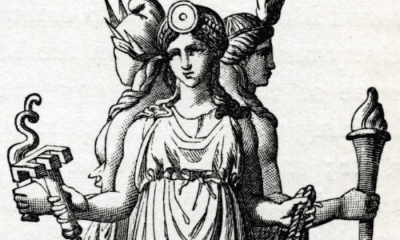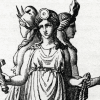Greek
What is Charybdis?
The great sailors of ancient Greek legends feared Charybdis, but what exactly was Scylla’s neighbor? Read on to find out the true dangers of the monstrous whirlpool!
The three great sailors of Greco-Roman mythology all faced the same choice. In navigating a narrow strait they had to sail past either Scylla or Charybdis.
Odysseus, Jason, and Aeneas all made different choices, but any ship sailing near the Strait of Messina faced danger. Scylla was a ferocious monster, but Charybdis could destroy an entire ship in seconds.
The enormous whirlpool was described as both a monster and a natural feature. However it was characterized, though, Charybdis was considered one of the most deadly dangers of the sea.
So where died Charybdis come from, and was she really as deadly as Homer made her out to be?
Charybdis the Whirlpool Monster
Charybdis was a giant whirlpool that was said to be large enough to suck in an entire ship. She lived in the narrow channel of water that separates Italy from Sicily, which was also home to the vicious monster Scylla.
When passing through this strait, sailors had to choose which monster they would sail closest to. The pass was so narrow that it was impossible to go through without being attacked by one of them.
Of the two, Charybdis was generally regarded as the more deadly because she could destroy an entire ship in an instant. Scylla’s six heads would grab sailors off the deck, but by moving through quickly enough only a few men would be lost to her before the vessel was out of reach.
Like many Greek monsters, Charybdis initially had no concrete origin story but later had one invented. As was common with many of these later additions to the mythology, Greek and Roman writers imagined Charybdis to have once been a beautiful maiden.
In this case, she was a daughter of Poseidon and Gaia. Charybdis was loyal to her father and used her power over water to serve him, particularly when he had a disagreement with Zeus.
Charybdis helped Poseidon once by flooding land that Zeus had patronage over. Worshippers fled the rising waters and crops and livestock were destroyed, so Zeus received fewer sacrifices.
Zeus was angry that his niece had damaged his lands, so he punished her harshly. He turned Charybdis into a monster that swallowed and expelled huge amounts of water three times a day.
These later stories gave the whirlpool an interesting story, but for most of Greek history Charybdis was regarded as a natural threat that was, like many monsters of mythology, made more dramatic and threatening than was typical.
My Modern Interpretation
Modern and ancient sources both place the location of Scylla and Charybdis in the real Strait of Messina, a narrow stretch of sea that separates Southern Italy and Sicily. While Scylla probably represented the jutting rocks that could harm a ship that got too close, Charybdis actually was a real whirlpool.
The whirlpool in the Strait of Messina is a feature that still appears today, although it is not nearly as dangerous as the legend would have it. The actual whirlpool of Messina is only a danger to very small vessels, and even then only in particularly bad circumstances.
It is possible that the story of the monstrous whirlpool that could devour whole ships grew up long before the time of Homer and the Odyssey. Smaller boats and more primitive navigation techniques of early cultures would have made even the small whirlpool of the Strait of Messina a true danger.
By Homer’s time, that was no longer the case and a ship like that of Odysseus had little to fear from the small whirpool. With larger and more advanced ships, the whirlpool had to be made monstrously large and powerful to present a real threat to heroic sailors like Odysseus and Jason.
An alternative explanation is that Charybdis did not represent Messina’s small whirlpool, but the movement of the tides.
One of the characteristics of Charybdis was that she swallowed sea water on a regular schedule. She was given the name Trienos, or Three-Times, because she kept to this daily routine.
Sucking in water would explain the three low tides of the day, while its expulsion explained high tide. Charybdis was not a local feature, but the center of a major world-wide change of the sea that happened several times a day.
In a narrow channel like the Strait of Messina, the changing tides could be just as dangerous to a ship as a huge whirlpool. Changing water levels could hide dangerous rocks just under the surface of the water, and even the slightest shift in position caused by changing tides could drive a ship into the sides of a strait that was so narrow.
Most readings of Scylla and Charybdis lead to the conclusion that ships were forced to sail closer to Scylla, who represented the rocks, to avoid being sucked into a whirlpool. But if Charybdis is interpreted as the force of the tides her power forced ships to go closer to rocks they would ordinarily avoid.
The story of Charybdis was expanded over time but, whether as a whirlpool or the source of the tides, the monster’s origins were in a real danger of the sea.
In Summary
Charybdis was a monstrously large and violent whirlpool that lived opposite the monster Scylla in a narrow strait. Sailors in Greek legend had to steer their ships toward one of two dangers because the passage was too narrow to avoid them both.
Of the two, Charybdis was generally agreed to be the most dangerous. The whirlpool was large enough to pull an entire ship beneath the waves, meaning possible death for everyone aboard.
Like many monsters, Charybdis represented a real danger. The literal meaning of the monster was more evident with the whirlpool than with other sea monsters, like Scylla who probably represented sharp rocks.
Even so, the story was eventually added to so that it included an origin story that made Charybdis a beautiful maiden who was punished by a god.
The real Strait of Messina contains a whirlpool, although it is not nearly as big and dangerous as that of the legends. It is likely that the legend of Charybdis originated when boats were smaller and more fragile so the threat had to be increased as seafaring improved to remain dangerous.
There is also some evidence that Charybdis represented the changing levels of the tides rather than a local feature. In a narrow space with jutting rocks, the sudden changes to the water that came with the tide could be even more dangerous than an enormous whirlpool.



